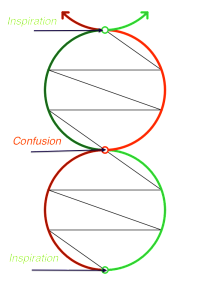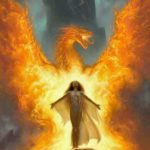Affirmation and Negation
The double-helix model will outline four ways of knowing reality, identified as realms of awareness. The term “realm” is meant to capture the all-encompassing quality of the experience: we operate within a realm like a fish swims in water. By contrast, a domain or sphere can be pictured as discretely separate.
But implicit to every way of knowing are the limitations of that way of knowing. So first there is an affirmation of a new way of knowing, and then the negation of the omniscience of that way of knowing. Here is where we get into the real dynamics of the double-helix: affirmation and negation are the thesis and antithesis, the ying and yang of the model. At first affirmation is explicit with the person having a new way of understanding the world. Negation is implicit at first as the person explores this new understanding, inevitably coming across the limitations of the new understanding. Then negation becomes explicit while a new affirmation becomes implicit.

Inspiration brings affirmation and savoring skills to consciousness, and then Confusion brings negation and coping skills to consciousness.
Affirmation and negation are associated with distinctly different experiences and realizations. Affirmation is experienced as expansion and opportunity; negation is experienced as restriction and limitation. Affirmation is associated with levity and negation is associated with gravity. Affirmation is in the fore-ground of consciousness; negation is in the fore-ground of self-consciousness. In this model, consciousness is initiated by inspiration; self-consciousness is initiated by confusion. We are drawn into the world by inspiration; we are thrown back on ourselves by confusion. Inspiration and confusion are realizations that occur to us and are the key cognitive emotions of the double-helix model. A realization is more than a cognition and more than an emotion — it is uniquely grounded in reality. [For more on “cognitive emotions,” see section at end of this page.]
The descriptions of the interactions between “explicit and implicit” and “affirmation and negation” show the differences between the double-helix and spiral models. Robert Kegan’s model of subject-object dynamics (repeated in his major works) picks up the figure/ground shift as the “subject” (ground) itself becomes “object” (figure) in self-consciousness. But his spiral formation leaves out the subconscious (implicit) accompaniment that interacts with consciousnessand self-consciousness in an on-going way.



